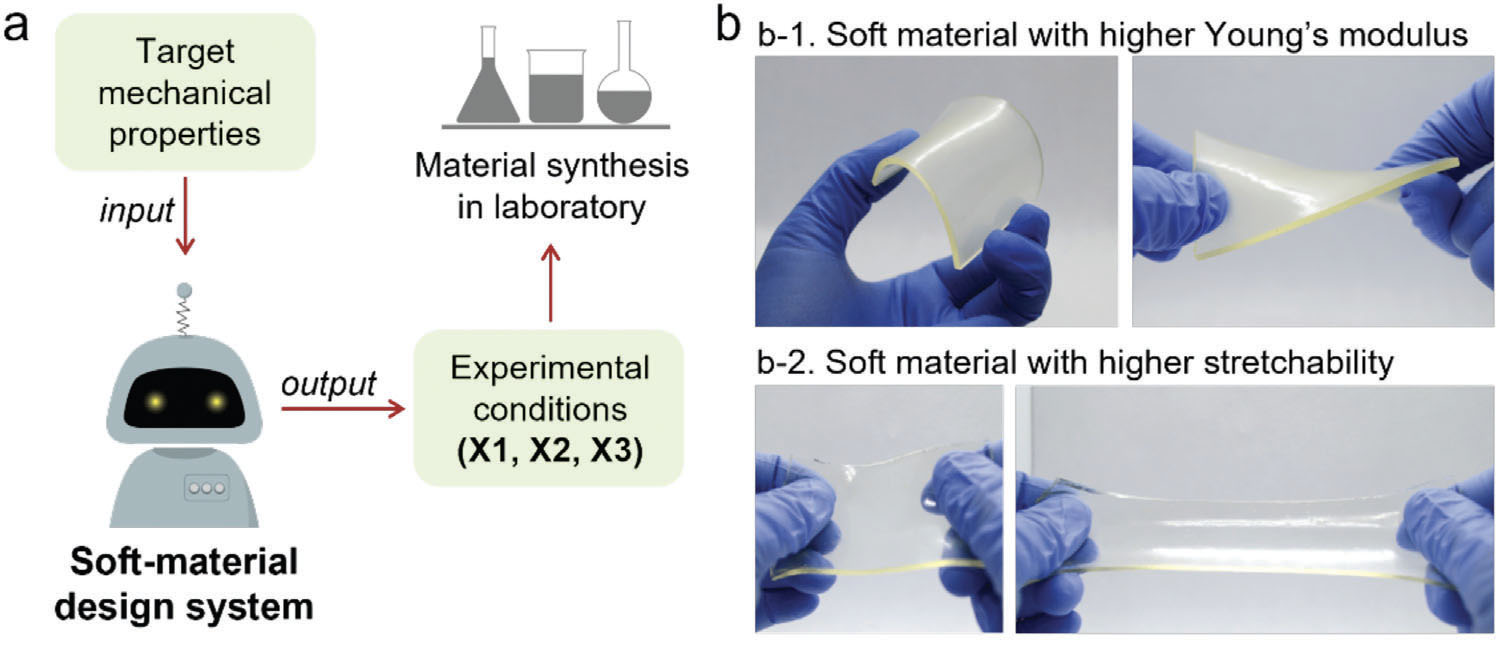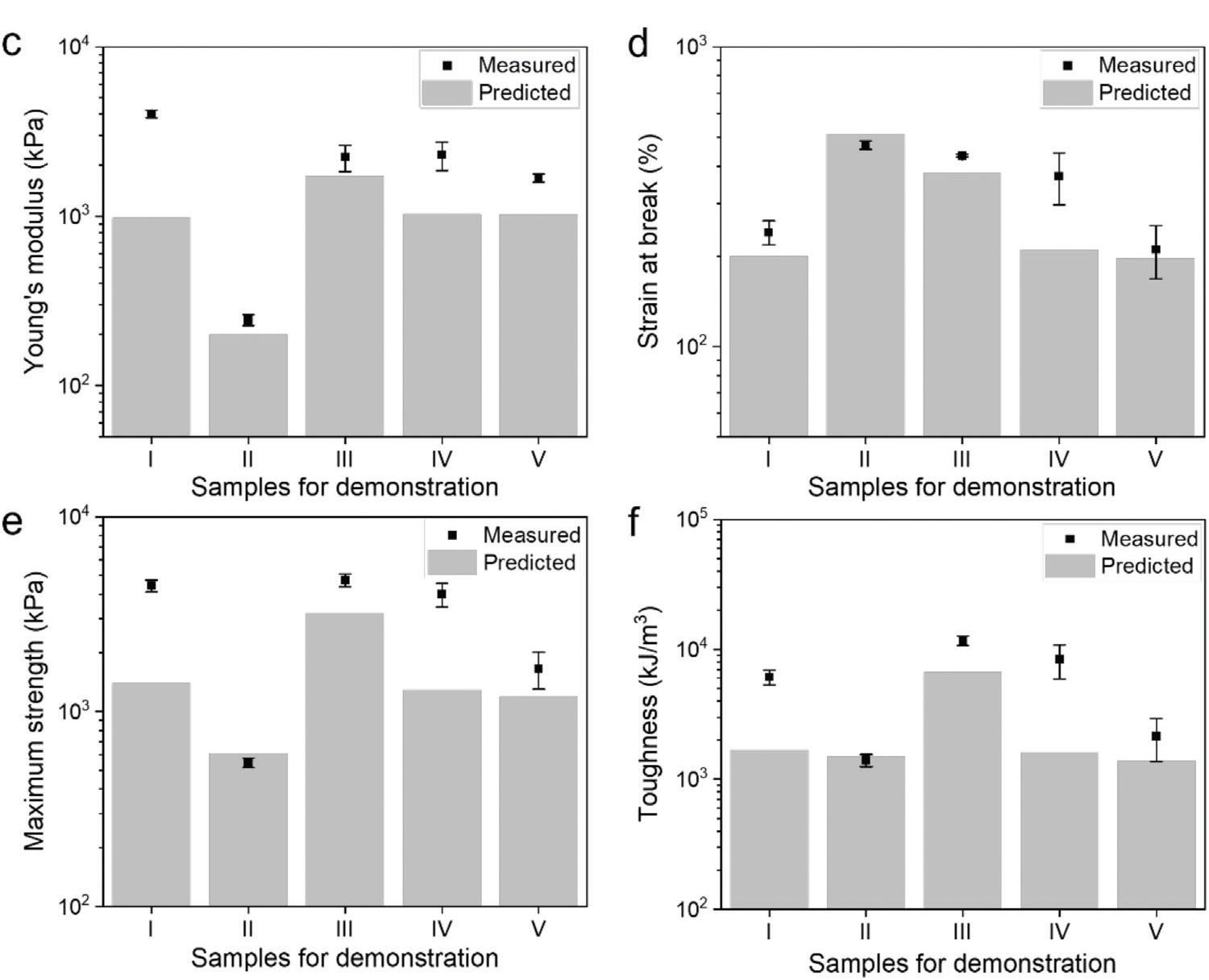| May 23, 2023 | |
Harnessing machine learning in designing soft materials |
|
| (Nanowerk Spotlight) Soft materials such as polymers, rubbers, and hydrogels play a significant role in your everyday life. From your car's tires to the elastic in your favorite loungewear, from cutting-edge flexible electronics to wearable technology like electronic tattoos — these versatile materials are everywhere. However, to use these materials effectively in such a wide array of applications, their mechanical properties need to be precisely tailored. | |
| For example, wearable sensors like electronic skin and tattoos need to be just soft enough — in scientific terms, they need a relatively low Young's modulus — to match the natural strain of our skin. They also need moderate stretchability to move with our bodies without causing discomfort. When used in soft robotics, these materials need a range of properties for biocompatibility or to mimic biological designs. Moreover, when used in artificial skins, the materials need to be robust, durable, and tough. | |
| The trick to achieving these unique properties lies in carefully manipulating aspects such as the polymeric chains, monomer composition, and intermolecular hydrogen bonding. However, tailoring these materials is not a trivial matter. It requires a deep understanding of material chemistry and multiple experimental trials. This process can be a significant hurdle for end-users who need materials with specific mechanical properties for their applications. Hence, a new approach to this design process is crucial. | |
 |
|
| Soft material design system and demonstration of the design process. a) Soft material design process using the design system. The system takes desired mechanical properties as input and returns experimental conditions in a form of (X1, X2, and X3). b) Examples of an elastomer with high Young’smodulus (b-1) and an elastomer with high strain at break (i.e., high stretchability) (b-2). (Reprinted with permission by Wiley-VCH Verlag) | |
The Rise of Machine Learning in Materials Design |
|
| This is where the power of machine learning and materials informatics comes into play. These advancements have significantly expedited the material discovery process. Machine learning algorithms can pick up on subtle patterns in datasets that would be challenging to identify through human intuition alone. This ability allows the reverse design of materials. That means using a set of desired material properties to determine the experimental parameters, which significantly accelerates the design process. | |
| However, using machine learning models in experimental studies comes with its challenges. Collecting the vast amounts of high-quality experimental data necessary for model training can be time-consuming and effort-intensive. Fortunately, innovative strategies have emerged to collect high-quality data with reduced effort, such as utilizing archived laboratory notebooks or applying experimental design techniques like the design of experiment (DoE). | |
A Data-Driven Approach to Soft Material Design |
|
| One exciting development in the field is the application of a data-driven approach to tailoring the mechanical properties of a soft material. In a recent study in Advanced Functional Materials("Data-Driven Approach to Tailoring Mechanical Properties of a Soft Material"), researchers from Stanford University demonstrated this approach using polyurethane (PU) elastomer, a common type of soft material. | |
| The team adjusted the mechanical properties of the PU elastomer by changing the mixing ratio of its components. They collected data on the material's mechanical properties, such as Young’s modulus, strain at break, maximum strength, and toughness. Using this data, they trained machine learning models to predict these properties based on the mixing ratios. | |
 |
|
| Five samples were prepared for experimental verification. The desired mechanical properties, labeled as “Predicted” in graphs, and the measured mechanical properties are presented: Young’smodulus c), strain at break d), maximum strength e), and toughness f). Error bars of “measured” data points indicate 1-standard deviation calculated from 3measured data. (Reprinted with permission by Wiley-VCH Verlag) | |
| The beauty of this method is that it can do 'reverse design'. You input the mechanical properties you want, and the model spits out the synthetic recipe to achieve those properties. The researchers tested this by creating elastomer samples using these recipes and found that the resulting mechanical properties closely matched the input properties. | |
| The researchers conclude that this data-driven approach to soft materials design, utilizing machine learning, can accurately predict and tailor the mechanical properties of these materials with a surprisingly small dataset. By focusing on macroscopic structural information controlled by synthetic recipes, this approach can provide soft materials with properties close to the desired ones. | |
| The success of this research could stimulate further discussion between materials research and artificial intelligence research communities. It could also spur the development of novel algorithms specifically designed for small datasets, a common challenge in the field. By utilizing data-driven approaches and machine learning, we can explore various soft material systems and design processes more efficiently, leading us one step closer to laboratory automation. | |
 By
Michael
Berger
– Michael is author of three books by the Royal Society of Chemistry:
Nano-Society: Pushing the Boundaries of Technology,
Nanotechnology: The Future is Tiny, and
Nanoengineering: The Skills and Tools Making Technology Invisible
Copyright ©
Nanowerk LLC
By
Michael
Berger
– Michael is author of three books by the Royal Society of Chemistry:
Nano-Society: Pushing the Boundaries of Technology,
Nanotechnology: The Future is Tiny, and
Nanoengineering: The Skills and Tools Making Technology Invisible
Copyright ©
Nanowerk LLC
|
|
|
Become a Spotlight guest author! Join our large and growing group of guest contributors. Have you just published a scientific paper or have other exciting developments to share with the nanotechnology community? Here is how to publish on nanowerk.com. |
|
